One of the reasons I decided to add a Brussels leg to my trip was that I was able to take a high speed train instead of an airplane from Brussels to my next stop: London.
I may have mentioned that I love traveling by high speed train. For example, I am traveling with one large case since I need business clothes for about 11 days and they just won’t fit in a smaller bag. Turns out that it is right at 50 pounds, so I moved some of the heavier things (i.e. jeans) into a backpack to make sure I had some room in the large bag. When I was looking up restrictions for bags on the train, they pretty much said that it needs to be less than three feet on the shortest side, and if you can get it on the train unassisted, you can bring it.
Heh.
I had an app installed on my phone to use the GPS to tell me speed, but it crashed and wouldn’t come back up, but we did hit 140 mph (on the way to a reported 180 mph) on the trip from Brussels to London.
Once in London I grabbed a cab and went to my hotel for the week, the London Marriott on Grosvenor Square.
I had never stayed there before, but I really liked it. With my newly won “Platinum” status I was escorted to my room by the manager, and they had placed an ice bucket with three Coronas in it as a welcome present. I knew that Craig Gallen was going to be in town for part of the week, so I had requested two beds so that he would have a place to crash. Usually in Europe that means twin beds, but these were doubles which made it nice.
Grosvenor Square is in Mayfair, which is a very posh section of town. I saw more Aston Martins, Ferrari’s, Bentleys and Rolls Royce cars parked on the street then I had ever seen anywhere else, including dealerships and car shows. There were lots of high end shops on streets like Bond, Regency and Saville Row. While I had been to London many times before, this was the first time I had been in this area and it was quite comfortable.
In walking around, I noticed for the first time that there are a number of these little round plaques on certain buildings. One mentioned the Bee Gees:
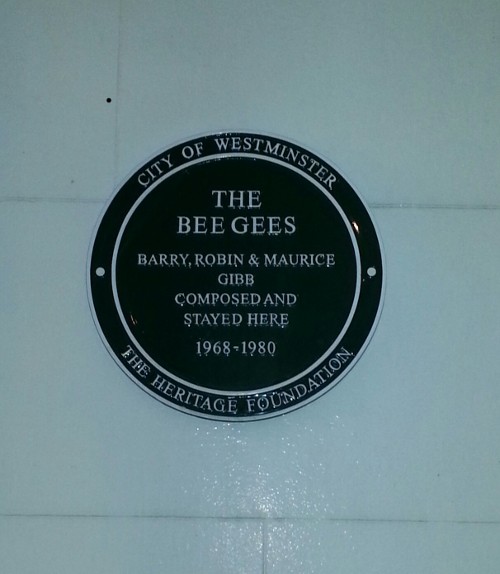
and another touted that John Lennon had stayed there:
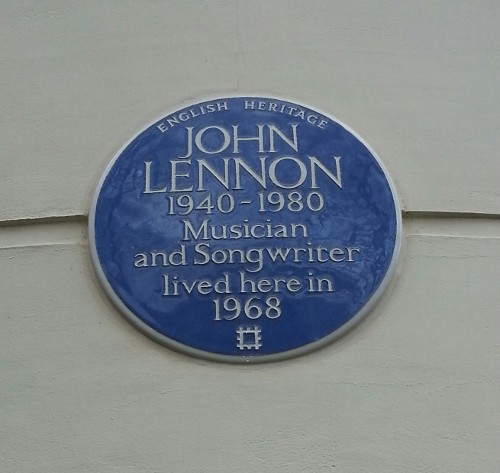
Pretty cool. I’ll need to look for them more on my next trip.
Not that I had too much time to spend looking at the sights. I was there to teach an OpenNMS class and I am in the middle of totally redesigning it, so my first couple of nights were spent working on slides. On Thursday, however, my friend Jonathan Sartin had invited me to see a presentation on “The Universe Within” at the Royal Institute by professor Neil Shubin.
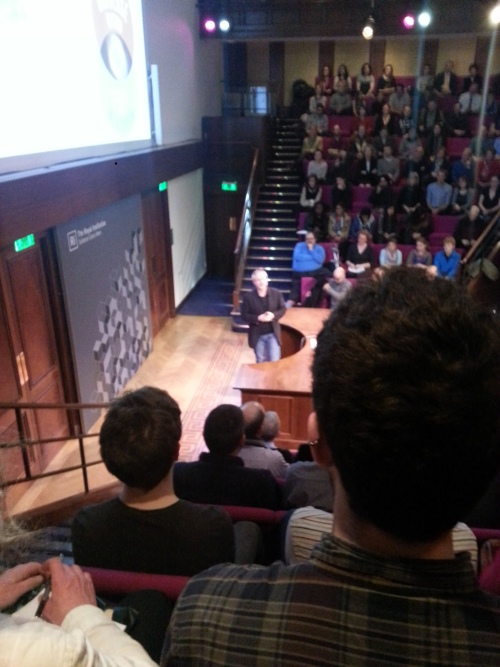
We got there a bit early, so I grabbed a local ale and we waited for Craig to show up from the Royal Society (a different “Royal”). The auditorium was pretty full and steeply pitched, which reminded me of some of the many colleges I attended.
Shubin is best known for finding a transitional fossil named Tiktaalik in the arctic region of Canada. A good portion of the hour long presentation was on finding it, starting with looking for fossils along the highways of Pennsylvania. As my family is originally from there, I can remember driving by these hills that were steeply cut so the road would run straight and you could see the different strata plainly. He was looking for fossils in the Devonian era (about 375 million years ago) specifically for an animal that closely resembled a lobed fish but with the flat head and neck of the later land dwelling amphibians. After several years he found it in Tiktaalik.
The talk was good, but at one point he mentioned that the Earth was actually speeding up and the days were getting shorter. This didn’t sound right to me, as I remember once in high school actually calculating the effect the Moon has on the Earth’s rotation and that it was slowing down (through its influence on tides). Furthermore, it would slow down until the rotation of the Earth (a “day”) matched the rotation of the Moon, which is a little more than 27 current days. When that happens, the Moon will spiral into the Earth, causing a few traffic jams and flight delays.
Actually, the calculations showed this was to happen in about 7 billion years, and by that time the Sun will be a Red Giant with a diameter out to about the orbit of Mars, so no worries.
Anyway, when question and answer session happened, I decided to call him on it. He pretty much corrected himself, “It *is* slowing down, the days are getting shorter … I mean longer. Did I say shorter? I meant longer” and left it at that, but Jonathan gave me points for asking a question at the Royal Institute on my first visit, and one meant to correct the speaker at that.
On the way out, I noticed that there were chargers out front for electric cars.
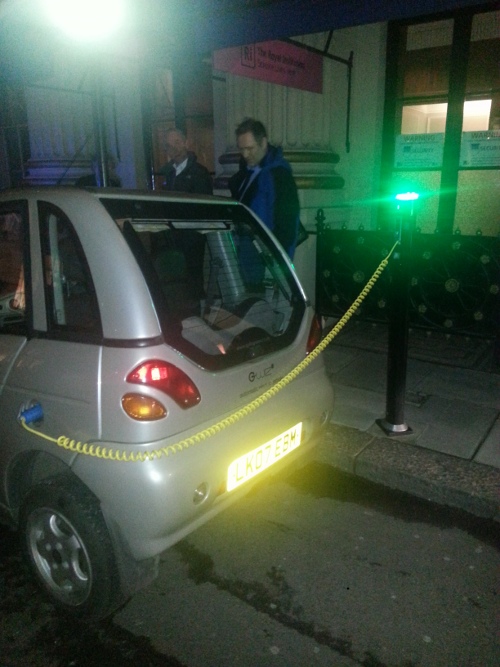
After the talk the three of us went to Wagamama, a Japanese-style fast food chain popular in London (Jonathan wanted to catch a train and wanted to get served quickly). Afterward, Craig and I went back to the room. On Friday I finished up my class and then took a car to the Heathrow Renaissance Inn in preparation for my flight to Sweden on Saturday.
Of course, my last thing to do in London was a proper pub lunch:
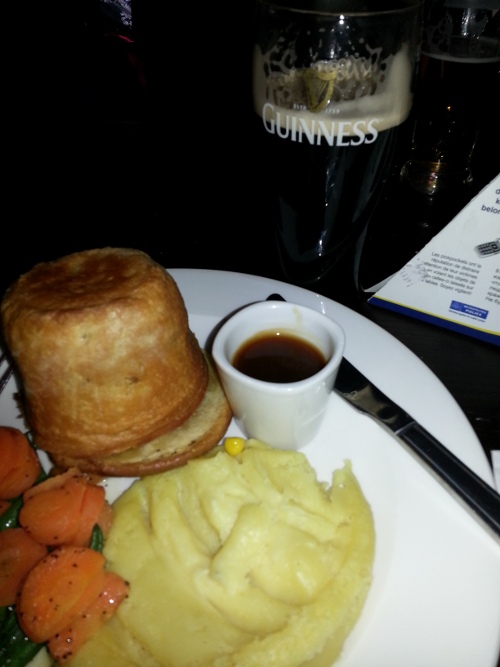
We are doing a lot of work in Sweden over the next year, and we need help, so I asked Alex Hoogerhuis, an OpenNMS guru and resident of Norway, if he was interested. He decided to fly to London just to have dinner. I looked him up when I got to the hotel, and immediately apologized for how crappy it was. In any case, we walked down the road to a pub called “[The Pheasant][9]” and had a nice meal, and afterward went to the lounge and talked about planes. He taught me the easiest ways to identify the most common commercial jets and I plan to write that up at some point.
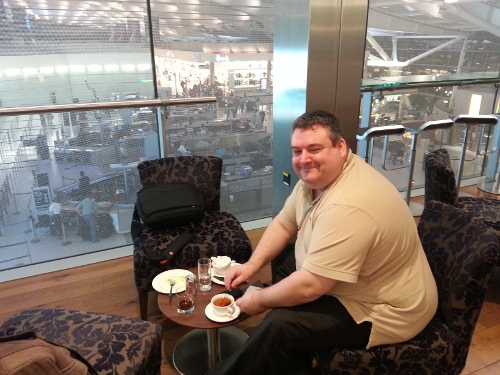
The next morning we took a cab to Terminal 5 at Heathrow and I got ready to leave for Sweden and he back to Norway. Since he no longer has elite status I was able to get him into the BA lounge, and he was able to show me a really cool, almost hidden section of the lounge where we waited for our gates to be announced. It was a fun visit and I hope to be working with him soon.
Next: Sweden.